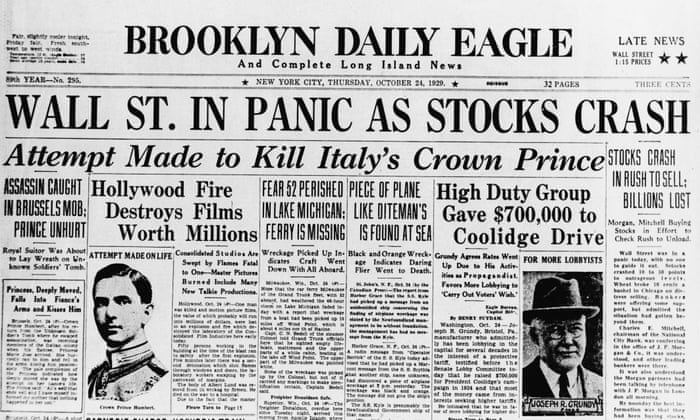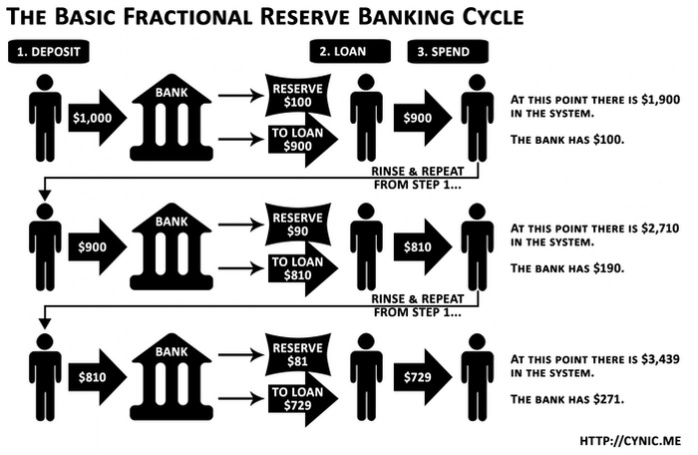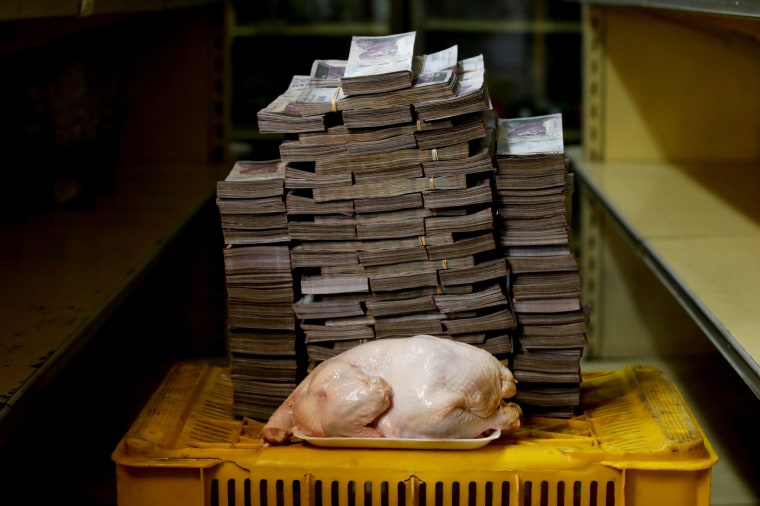
Inflation can be a vexing topic, because it involves the amorphous concept of money. However, inflation is actually a simple topic made complex by the separation of money and other goods. In this article, we break down inflation and its causes.
The simplest definition of inflation is a rise in prices for goods and services. When prices rise, this also means the value of a unit of money – like a dollar – falls. Take the example of a McDonald’s hamburger: in 1955, this humble hamburger sold for only 15 cents. In 2018, it sold for $1.09 – a whopping 626% rise in price.
This means the dollar lost a lot of value. You could buy almost 7 hamburgers in 1955 for a single dollar bill. In 2018 that dollar wouldn’t even buy you a single hamburger. Why do prices always seem to rise over time? And what can you do about it? This article aims to answer those questions.
Economists attempt to summarize the rise in prices for many goods and services as a single average number. This number represents the change in the total cost of the average consumer’s annual expenses, like rent, food, and gas.
In the United States, this number is known as the Consumer Price Index, or CPI. When the CPI increases over a period of time, economists say we are experiencing inflation. When it decreases, this is termed deflation.
What causes inflation?
Many sources say that the constant inflation we experience today is either caused by an increase in demand (demand-pull) or a decrease in supply due to increased production costs (cost-push).
These reasons are incorrect – let’s look at why.
To understand the real reason for inflation, we must look at two types of inflation:
- Price Inflation: Prices rising over time.
- Monetary Inflation: The amount of currency in circulation rising over time.
The first, price inflation, rarely occurs over long periods (decades, centuries) because of increased demand or increased costs. Why? Markets tend to balance themselves out. Throughout history, we have repeatedly seen that increased demand for a good drives up its price, which incentivizes producers to produce more of that good. When supply increases, prices come back down.
This cycle may take several years, but it occurs for almost every commodity and ‘final good’ (cars, TVs, food, etc) on Earth. The only exceptions are rare metals like gold and silver. Evidence of this is shown below.
When the cost to produce a good increases, the price of that good often increases to cover those costs. This rise in price causes consumers of that good to look for alternatives to it or reduce their consumption of that good, leading the price to fall back down to previous levels.
In the below two graphs, price inflation is occurring!
But the market naturally balances itself out, and prices go back down either through an increase in supply or reduction in demand.
Do we have evidence that markets balance supply and demand over time?
Data on prices for goods over time can give us a better understanding of whether markets actually do balance supply and demand effectively. However, we cannot look at prices in terms of national currencies, because our governments are always printing more of their national currencies.

They are conducting monetary inflation, which can cause price inflation. Looking at market prices in terms of national currencies, like the US dollar, is like measuring your height with a ruler that keeps shrinking. Your height in number will be bigger and bigger, but your actual height is not changing.
We can know whether markets are balancing supply and demand by looking at the prices of goods in terms of a monetary good that has a very consistent supply over time.
Over time, gold has proven itself to have the least monetary inflation of all currencies and commodities in existence. This makes gold a great ‘ruler’ for measuring whether markets balance supply and demand over time. To get a better understanding of price inflation over time, we will ask how many ounces of gold something costs over time.
Prices in gold show us that markets balance over time
If we look at prices for goods in terms of gold, we see the prices for commodities tracking midpoints over long periods of time.
Oil, for example, is very volatile but tends to bounce around 2.5 grams of gold per barrel.

Home prices over the past 10 years are also fairly stable, even though we have a fixed amount of land on Earth. We see home prices in terms of gold tend to vary around an index price of about 80 on the chart.

Graphed in US dollar terms, prices for these goods are always rising – just like the McDonald’s hamburger. If increased demand or increased costs were responsible for constant price inflation, we would also see the price for these goods increasing in terms of gold. The data above shows prices are constant.
There must be other reasons for the persistent price inflation we’ve seen in dollar terms over the past century.
Here’s what we know affects prices over the long term, like the time period from 1955 to 2018:
- Productivity growth from innovation, which causes prices to fall over time
- Monetary inflation – the printing of more currency – which causes prices denominated in that currency to rise over time
We know prices in terms of dollars, euros, and other currencies are going up steadily. Unless we think that our productivity as a society is going backwards, there is only one simple reason for price inflation: the printing of more currency, or monetary inflation.
Our governments and banks are actually fairly honest about the staggering amounts of currency they print into existence. They are telling us every day that they are causing monetary inflation.
Do we need to have inflation?
Without persistent monetary inflation (which causes price inflation), our entire modern economy would collapse.

Let me explain. The next section may come as a shock, but I encourage you to do your own research if you think I am wrong.
When central banks and commercial banks make loans, they create new currency.
When central banks make loans to governments by “buying government debt” they create new currency when they do so. This enables governments to run a budget deficit by spending more than they take in from taxes. They rack up national debt in the process.
Commercial banks create new currency when they make loans to individuals and businesses. The only restriction on how much new money they can create is a legal requirement for the bank to have on hand a certain percentage of the total amount of money people deposited.
This is why our banking system is known as fractional reserve – banks are only required to keep a fraction of your money on hand.

Currency creation is necessary to keep the system alive
Since all loans are mainly made up of newly created currency, even more currency must be created to pay off that debt. Here’s why:
Let us say that last year, all the world’s lending activity led to the creation of 100 billion dollars. All of those 100 billion dollars are newly created, so they are owed back to a bank somewhere with some extra cents for interest. Where does this extra currency come from to pay the interest? Since we are talking about the entire world economy here, interest payments must come from more new currency.
All units of today’s currencies came into existence through lending, and paying off the interest on those loans means we must constantly create more new currency. This leads to endless monetary inflation. When this new currency circulates in the economy, it leads to rising prices: price inflation.

The monetary system falls apart if this monetary inflation stops because this would mean a large number of borrowers all over the globe would not be able to pay back the money they borrowed – they would ‘default’ on their debt. The banks, or lenders, that hold the debt would then be holding a worthless asset. Since the value of the debt backs the value of the currency, the currency’s value would plummet along with the debt.
When people lose confidence in a ‘fiat’ currency, it quickly becomes worthless. This happened in Germany after WWI, Peru in the 1990s, Zimbabwe, Venezuela, and to countless other fiat currencies. To put off this inevitable outcome as long as they can, central banks boost confidence in the system by continuing to print currency at a steady rate.
This ensures most borrowers have the currency to pay off their loans. This is exactly what’s happening when the government does a “bailout” like in 2008 or in 2020 – they are ensuring everyone has enough money to pay their debts, so the ruse can continue.
Inflation does not come from increased demand
With more currency circulating, monetary inflation may look like increased demand. However, economists who say increased demand drives steady inflation over decades miss a subtle point: while monetary inflation may cause more spending, it is not because people are truly wealthier but because they believe they are wealthier. When lots of currency is injected into the economy, prices simply rise because more currency is chasing the same amount of goods. A rise in prices means a drop in the value of the currency, so there is no actual increase in real wealth although people may be “spending more” in nominal amount of currency.
Take this example: You make $3,000 per month, and at your current lifestyle you spend about $3,000 per month. The government comes along and starts giving you an extra $1,000 every month – you feel pretty great, right? You might go out to eat a little more often.
However, the government is giving everyone $1,000 dollars extra per month, and everyone else is spending it too. The economist in his office at the Fed sees everyone now spending an extra $1,000 per month, and concludes that the government has ‘stimulated the economy’.
However, as all this extra money circulates in the economy, prices naturally rise. It now costs you $4,000 to sustain your current lifestyle.
Are you any wealthier?
You may have more dollars in your bank account, but each one buys you less. You now spend $4,000 per month to live the lifestyle that used to cost you only $3,000 per month.

This is what monetary inflation does, and why so many smart economists are fooled into thinking increased demand, rather than printing money, drives persistent price inflation.
Have we always had inflation?
Constant price inflation is a relatively recent phenomenon in modern economies and started around the time the United States began printing currency continuously. If supply and demand changes truly caused price inflation over the long term, we would see price inflation throughout history. The data tells a different story.
The Consumer Price Index, which increases when we experience price inflation, was fairly constant prior to the start of our current ‘fiat’ monetary system. That system began with the Bretton Woods agreement in 1945 and accelerated when Nixon ended the worldwide gold standard in 1971.
How is inflation measured?
Price inflation is often reported as a change in the Consumer Price Index (CPI). The CPI is an average of the prices for various goods that people purchase in their day to day lives: food, gasoline, housing, etc. In the United States, a government department called the Bureau of Labor Statistics (BLS) measures changes in prices. They do this by visiting retail stores, recording prices, computing an average, and reporting the annual inflation as the change from the past year.
The reported inflation rate is important to everyone because it is used to set cost-of-living wage increases and social benefits, like Social Security payments. When the CPI is adjusted downwards, wage and benefits payments are less than they should be.
The effects compound over time: a person making $40,000 in their first year of employment would end up earning only $52,000 in their 10th year with 3% cost-of-living wage increases to match inflation. If the government reported 6% inflation instead, that person would earn $67,500 in their 10th year – about 30% more. How we compute and report inflation makes a huge impact on the earnings of most employees and citizens.
Here’s inflation (percent change in CPI) measured over the last 10 years in the United States:
Originally, the BLS simply recorded the price of a basket of consumer goods each year. However, research by the Boskin Commission in 1996 led to new tools that allow the Bureau of Labor Statistics to adjust prices in the CPI. Two of the most important tools are geometric weighting and hedonics.
Geometric Weighting
Geometric weighting means buying habits can now influence how much the price change of a single good impacts the CPI. If consumers purchase less of a good, it has a lower weight when averaged in the CPI. The Boskin Commission claimed this change would help reflect changing consumer preferences. However, there is no way to tell whether people are changing their buying habits because they actually want to buy different things. It is very possible that people are buying less of a certain good because it’s rising in price. Geometric weighting, therefore, causes goods with large price increases to have less impact on the CPI, leading to lower reported inflation.
Hedonics
Hedonics allows the Bureau of Labor Statistics to change a good’s price based on its perceived ‘utility’ increases over time. Here’s an example: say a TV with 720p resolution sold for $200 in the year 2009. In the year 2010, the same model of TV now has 1080p resolution and sells for the same price: $200. However, because the technology in the TV improved, an employee of the Bureau of Labor Statistics can make up a ‘utility’ number and use it to subtract from the price of the TV. As a result, the BLS can say the TV costs $180 in 2010 – even though its price tag shows $200. This leads to a drop in reported inflation.
Both of these adjustments lower the reported inflation rate, which lowers cost-of-living wage increases and Social Security benefits payments. How much are the working class and retirees affected by these inflation adjustments? Some estimates, like those from Darmouth-educated economist John Williams, put actual inflation in the United States at regularly 3% – 6% higher than reported by the Bureau of Labor Statistics. That would make inflation 5% – 8% today instead of the reported 2%.
Does inflation drive economic growth?
Many people believe that steady inflation drives economic growth by spurring investment and spending instead of saving. However, basic economic data refutes this common claim.
If we take the United States as an example, the nation had only short periods of inflation from 1775 to around 1950, as shown by the Consumer Price Index staying flat. Inflation really takes off after 1971, so we would expect to see the rate of growth in the Gross Domestic Product (GDP) of the United States increase after 1971.
However, we see that the Gross Domestic Product (GDP) per person in the United States, a common measure of economic strength, has steadily increased since 1820 to today at a rate of around 1.85% per year. There is no increase around 1971, despite rampant inflation beginning at that time.
For more, see here under heading: Growth at the technological frontier and catch-up growth
This shows that inflation does not drive economic growth.
Unfortunately, we do have evidence that inflation has other undesirable consequences, like wealth inequality. Wealth concentration in the top 1% started increasing in the late 1970s, a few years after the United States took the world off a gold standard and into a debt-backed monetary system which requires monetary inflation, and thus price inflation, in order to survive.
For a full history of the transition of money from commodity-backed to debt-backed, read our piece on money.
Does inflation drive or diminish wealth inequality?
The connection between inflation and wealth inequality becomes clear when we look at how newly created currency enters the economy. Governments, commercial banks, large corporations, and the wealthy often use loans to gain the advantages of leverage. When they take out loans, they receive newly created currency earlier than everyone else. They benefit from inflation by spending the new currency before prices begin to rise as a result of that new currency circulating in the economy. Large and wealthy entities are often able to get loans at lower costs than the average citizen or small business as well. This means they can grow their operations and wealth faster than smaller firms.
Inflation hurts those who earn wages and cannot invest much of their income. Wages change slowly, sometimes only renegotiated annually. As a result, prices for basic goods and services often rise long before wages do. Cost-of-living wage increases also shrink with the manipulations to the CPI that hide inflation increases.
Where is inflation occurring today?
Record high inflation is occurring in countries such as Venezuela, Zimbabwe, Turkey, and Argentina. This causes trade and political stability to break down.
In the developed world, governments are reporting low price inflation. However, the global banking system is creating tons of new currency – there is a lot of monetary inflation going on. Central banks cause more currency creation by lowering interest rates. This makes it cheaper for corporations and individuals to take out loans, and every loan means new currency creation. Since 2008, almost all major central banks have set interest rates near zero.
Many central banks also loaned huge amounts to governments and failed banks after the 2008 financial crisis. In a few short months, this doubled (sometimes tripled or quadrupled) the money supply of many nations. They called this ‘quantitative easing’.
If banks are doing so much monetary inflation, why don’t we see price inflation?
Simply put, most of the new currency has not reached the hands of regular people. When regular people are able to spend newly printed currency on their everyday goods, we will see the CPI and inflation spike.
Today, most currency enters the world through bank loans, so banks play a big role in where inflation happens. Banks are primarily lending to very ‘safe’ clients like wealthy individuals, governments, and large corporations. These entities are turning around and buying luxury goods, fine art, financial assets, and government bonds. Prices of these assets are not included in the CPI, so reported inflation is low. As a result, wage increases and Social Security payments are also low.

What happens when new currency lands in the hands of regular people?
Unfortunately, someday all this new currency will enter the normal economy and drive up prices for everyday goods. This may happen in 2020 as a result of COVID-19 stimulus programs in the United States, which will distribute trillions to the people. While this is certainly preferable to bailing out corporations, every type of bailout that involves printing money has nasty long-term effects.
What we are experiencing now happened in Germany during and after WWI. Prices in Germany actually fell during WWI despite high currency creation by the German central bank. Low confidence in the economy kept the German people from spending money. However, once the war ended and people began spending again, prices skyrocketed and the currency became worthless. This could happen in the 2020s in the United States, given the stimulus programs being proposed.
Policies like Universal Basic Income (UBI), which look favorable for their promise to “bail out the people,” may also trigger hyperinflation. Regular people would feel wealthier, spend their newly printed currency, and cause prices to rise rapidly. This would essentially cancel out the positive impact of citizens getting “free money” every month.
So how can you protect your savings from inflation? Buy assets that are scarce, undervalued, and difficult for governments to seize. These assets are precious metals like gold, and Bitcoin.
What is deflation?
Deflation means a fall in prices over time. Many economists say this will cause people to hoard currency and lead to economic collapse as people stop buying goods and investing in businesses. This is simply not true since people always have needs and desires which require them to buy goods. Steadily falling prices over time would simply change the psychology of the consumer culture we live in.
Consumer culture comes from inflation
How is this true? Let’s look at an example. Say you want a new sports car and you have just enough money to buy it. In our world, you know because of constant inflation your money is becoming less and less valuable over time. In a parallel universe where constant deflation is occurring, your money is becoming more and more valuable over time.
- With constant inflation, the car will cost a bit more next year and the year after. You aren’t sure where to invest your money to safely preserve its purchasing power over time. If you are unsure whether to buy the car, it makes more financial sense to buy it right now to get the best deal.
- With constant deflation, the car will cost a bit less next year and the year after. If you just hold on to your money, you’ll get a better deal on the car next year. If you are unsure whether to buy the car, it makes more financial sense to wait a bit longer to get a better deal.
Now think about those two scenarios, multiplied across billions of people and products. With constant inflation, everyone has a little more reason to buy things right now. With constant deflation, everyone has just a little less reason to buy now. It is in this way that inflation is at the root of our materialist, consumer culture. Deflation could be the cure.
Inflation causes bad investments
Your money loses 2% of its value per year through inflation. Now, say Stew asks you to invest in his Taco Shop. After looking at the numbers, you believe you will lose 1% of the value of your money on this investment. A 1% loss in Stew’s business is better than a 2% loss from inflation, so you decide to invest. This is malinvestment – you are going to lose some value by investing. However, holding your currency is even worse, so you make the investment.

Many investors, like pension funds, are forced to invest in losing businesses today because of investment mandates and the sheer size of their ‘assets under management’.
Proponents of constant low inflation believe that deflation would reduce investment. However, it would only reduce investment in businesses with a negative expected return like Stew’s Taco Shop. For example, let’s say deflation averages around 2% per year. In this market, investors would simply stop investing in projects that they think will earn them less than a 2% annual return on investment.
A slightly deflationary currency will discourage investment in fake businesses and encourage investment in solid businesses that add value to the world.
What impact does inflation have on society?
Inflation drives increased spending, decreased saving, and increased debt. All of these things keep most people working longer hours and later in life. While inflation punishes wage-earners, it enriches holders of any asset that appreciates when new currency enters the system. These assets include stocks, fine art, real estate, and other assets that the wealthy use to store their wealth.
Over time, people and firms invent new ways to create goods and services with a higher quality more cheaply. This is known as ‘productivity growth’ and it should cause prices to consistently fall over time, not rise. It is only the constant currency creation necessitated by our government’s debt-based monetary system which causes constant inflation and its ill effects.
If you like my work, please share it with your friends and family. My goal is to provide everyone a window into economics and how it affects their lives.
Subscribe to email updates when new posts are published.
All content on WhatIsMoney.info is published in accordance with our Editorial Policy.
